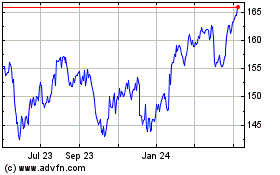P&G Moves to Streamline Its Structure
09 November 2018 - 9:20AM
Dow Jones News
By Aisha Al-Muslim
Procter & Gamble Co. said it would revamp its management
structure, shrinking the number of business units from 10 to six
and giving the heads of those products control over regional sales
teams as well as some functions previously run by headquarters.
The new organization, which will take effect next July, is part
of a continuing effort by the maker of Pampers diapers and Crest
toothpaste to streamline its operations. The company has been under
pressure to improve its performance from activist Trian Fund
Management, which waged a proxy fight last year and whose
co-founder, Nelson Peltz, now sits on the P&G board.
"There is a need for greater agility," Chief Executive David
Taylor said Thursday in an interview. "Frankly, the volatility we
see in many parts of the world -- the currency volatility, the
commodity volatility and just the level of competitive disruption
-- has increased meaningfully the speed of change."
Last month, P&G reported its strongest quarterly sales gains
in five years, snapping a stretch of lackluster growth. The gains
were a signal that the consumer products giant may be entering a
period of more robust growth after a yearslong struggle to adapt to
rising competition, higher costs and a consumer shift toward
smaller brands.
How P&G should be organized has long been a debate within
the more than 180-year-old giant, which employs roughly 92,000
people around the globe. Before Mr. Peltz's campaign, the company
had a matrix management structure with executives responsible for
key brands and others responsible for key geographies.
Mr. Taylor, who took over in late 2015, previously reorganized
the company to create 10 global business units, each with a
president responsible for a product category such as baby care or
oral care. But he kept six geographic sales and distribution teams,
each led by a president.
Starting in July, P&G said Thursday that it will have six
business units and each will have their own CEO who will report to
Mr. Taylor. The CEOs of the business units are the same executives
currently overseeing those product categories.
Four unit presidents will now report up to these unit CEOs and
the role of the sales presidents will be eliminated. A spokesman
said no executives were leaving as part of the reorganization.
Each unit CEO will be responsible for direct sales, product
innovation, and supply chains for the 10 largest geographic
markets, including the U.S., China, Russia and Germany. Those
markets account for about 80% of the company's sales.
The smaller markets such as Latin America, Central Europe and
Central Asia will be organized into a separate unit, which will be
overseen by the company's finance chief Jon Moeller, who will add
the title of chief operating officer.
The chunk of those smaller markets have "volatile countries with
currency and geopolitical dynamics," Mr. Taylor said.
The company said it would reduce its corporate functions, with
about 60% of corporate work shifting to the new business units. But
P&G, which will retain its corporate research and development
group, declined to say how many jobs could be affected by the
latest restructuring. In the past, the company has cut thousands of
jobs without making an announcement.
When asked if there will be job cuts, Mr. Taylor said, "The
business leaders will decide over time if changes need to be made
to adjust to market conditions and opportunities."
The company cut 3,000 jobs globally in the fiscal year that
ended in June. It has reduced its workforce by 25% in the past five
years, leaving 92,000 employees world-wide. The company shrunk
significantly in 2016 when Mr. Taylor completed the sale of
Clairol, CoverGirl and most of its beauty brands to Coty Inc. for
$12 billion.
Despite strong growth in the September quarter, executives
sought to tamp down expectations and stuck with their full-year
forecast for organic sales to rise 2% to 3%. At its investor day
Thursday, P&G didn't update its financial targets.
(END) Dow Jones Newswires
November 08, 2018 17:05 ET (22:05 GMT)
Copyright (c) 2018 Dow Jones & Company, Inc.
Procter and Gamble (NYSE:PG)
Historical Stock Chart
From Mar 2024 to Apr 2024

Procter and Gamble (NYSE:PG)
Historical Stock Chart
From Apr 2023 to Apr 2024
